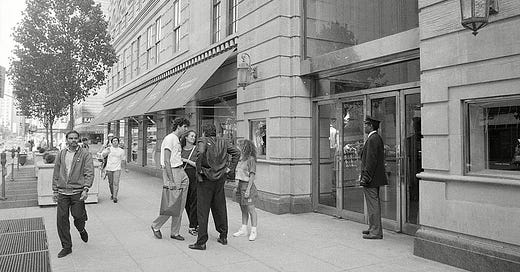How department store investors can claim the crown of cultural relevance
Every investor bro and ex-banking CEO who is on the board of an influential department store or e-commerce platform is convinced that they are part of fashion. They are convinced that they understand art. They are convinced that they are part of culture because they own a CDG heart T-shirt, wear Byredo perfume, and visit the Miami Art District. They believe they can buy taste and, therefore, buy up iconic fashion companies and "save" them simply by applying 2000s tech-industry thinking. This infiltration of the tech and banking industries has resulted in most department stores being stripped to the cold bone of efficiency. Having a stand-out vision which would inspire the public has been squeezed in favour of dull numeric KPIs and ROI, ironically sinking iconic companies into bankruptcy.
In this ocean of soulless department store retail, the opportunity for one store to plug into the zeitgeist with a stand-out purpose which represents the best of our time (and not the worst), is huge.
For that to happen, investors must firstly be convinced in the long-term financial benefit of running a store with a distinct point of view, one that recognises what people are craving in this post-covid-dead-internet-the-cost-of-living-crisis-doom-news era. A visionary retail investor, would write a no BS vision in support and elevation of purpose-driven independent brands, makers and communities, alongside commercial “maison” brands. From that, a new set of invigorating goals for measuring numerical and non-numerical goals would flow.
Secondly, the C-suite need to entrust senior staff to feel into what’s happening culturally, not just commercially. To let them uncover and represent the incredible art, music and cultural movements which have micro-communities and are envisioning a future built on planetary needs, equality, care, recycling, art… The way Barneys Art Director, Doug Lloyd, recalled of his work:
"[We] definitely weren’t given any boundaries...if anything, the only [rule] was to make it new and exciting. If it didn’t amuse, challenge, or thrill, it wasn’t going to happen.”
And thirdly—but most importantly—multi-brand retailers need to genuinely listen to the needs of creatives and meet them where they are headed. They must trust and support them beyond clickbait marketing campaigns. They must be open to representing the messiness of life with all its abundance, awe, opinions and individuality.
The first multi-door department store, or e-commerce platform, to establish a modern point of view—to entice us away from the nauseating sludge of doom scrolling—will be the one to claim the crown of cultural relevance and command the fashion industry to use its power to represent the goodness of our world.



